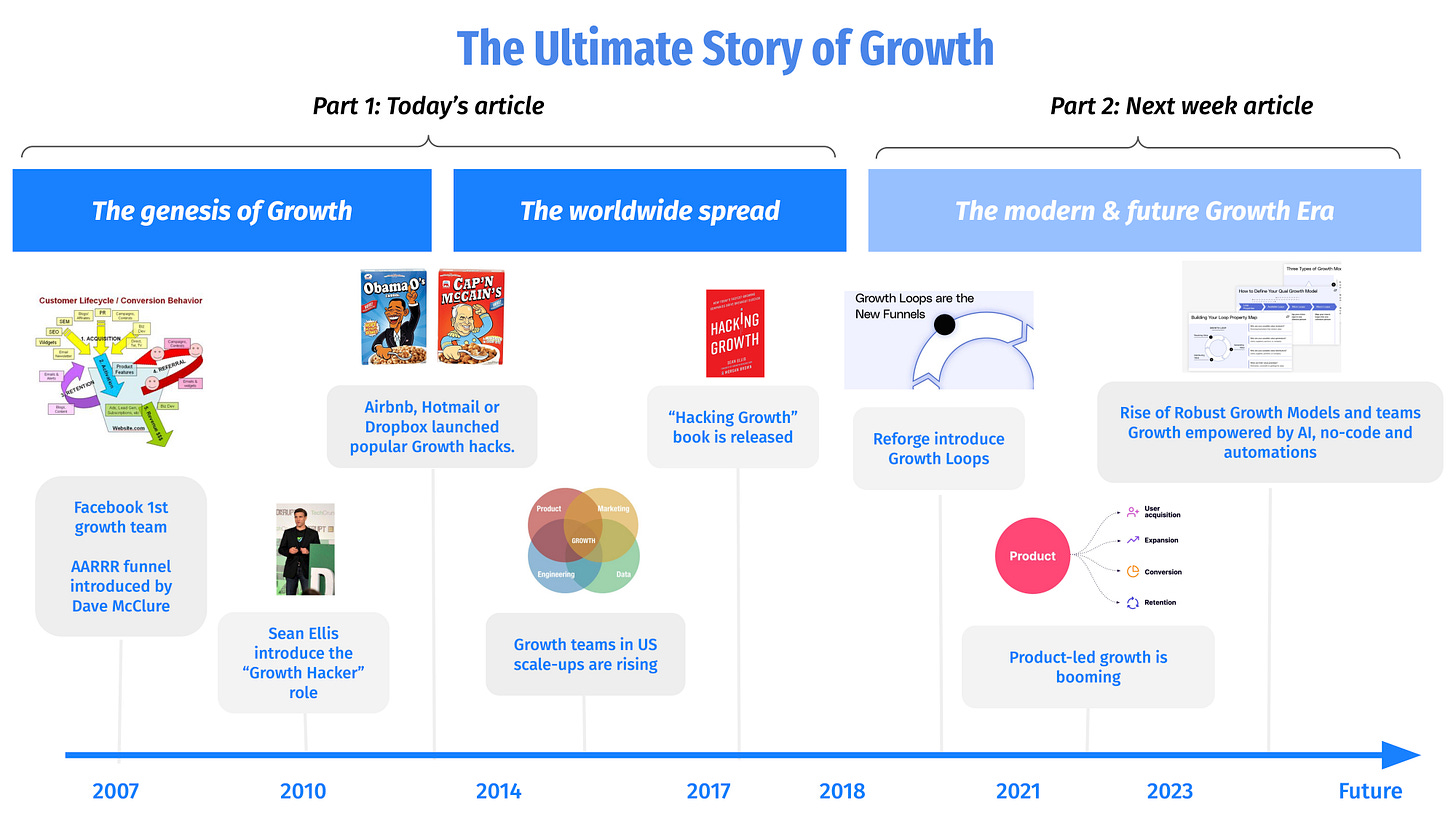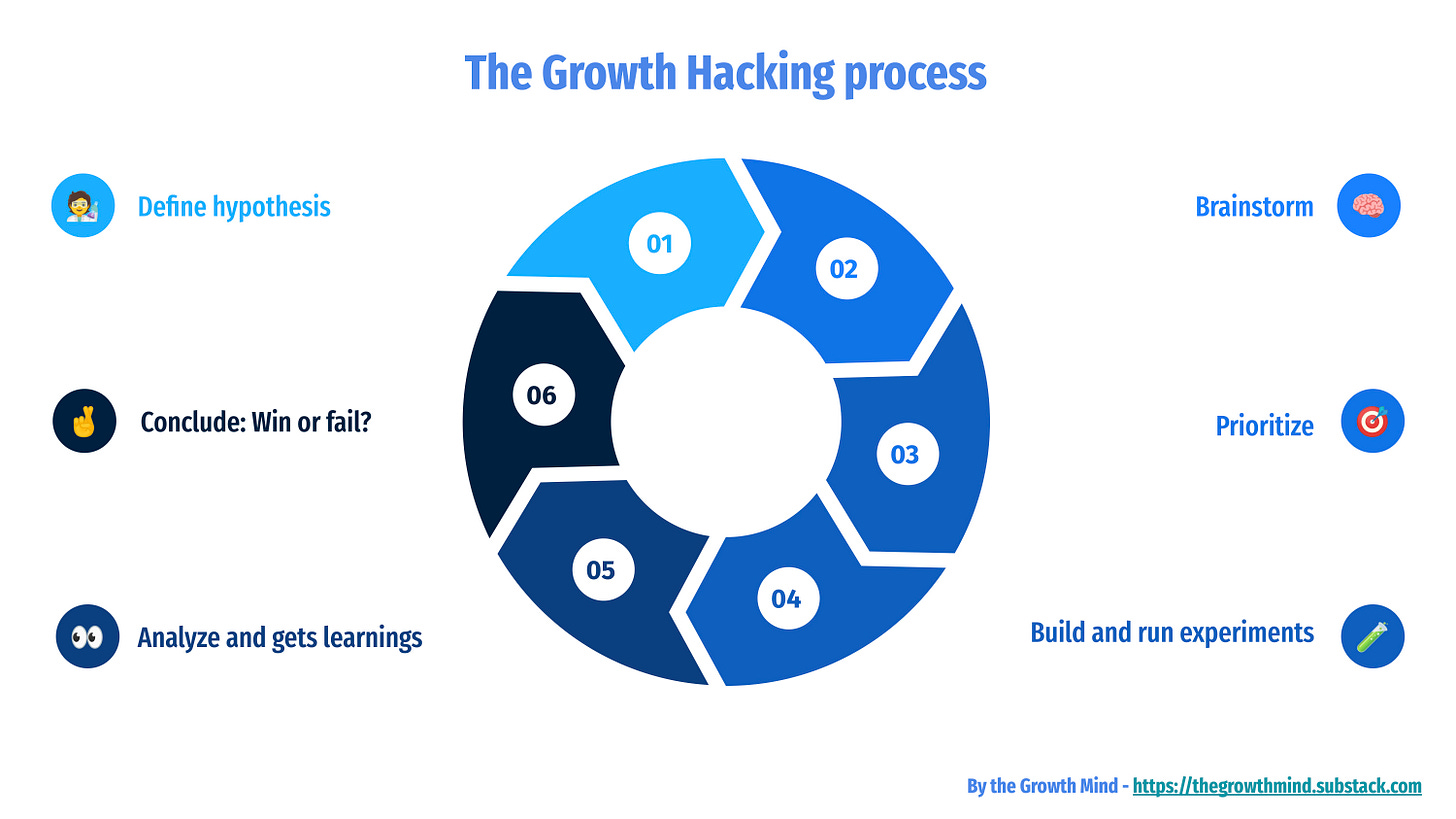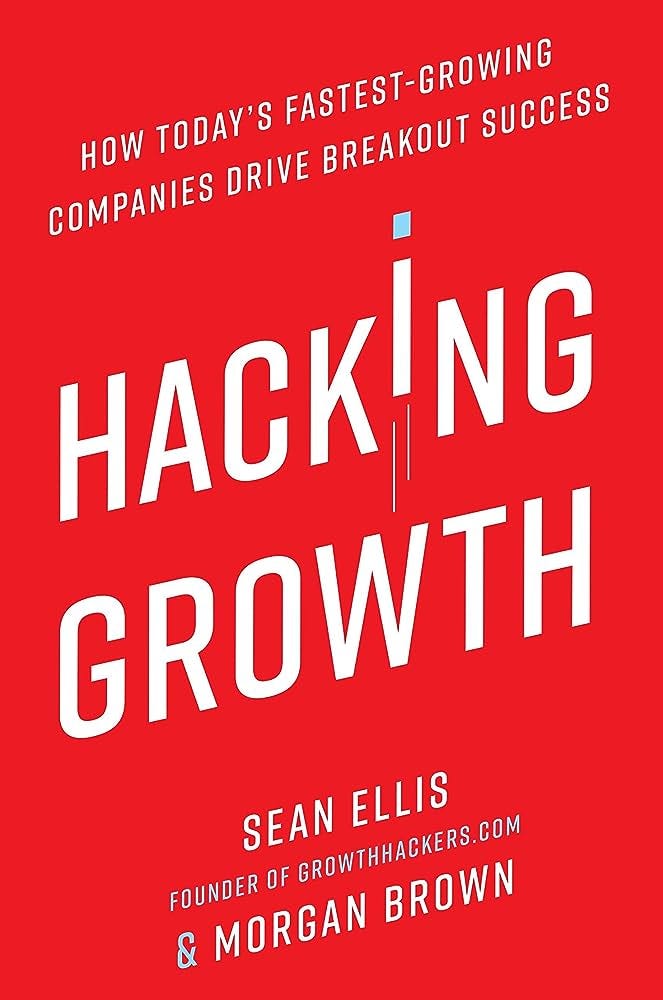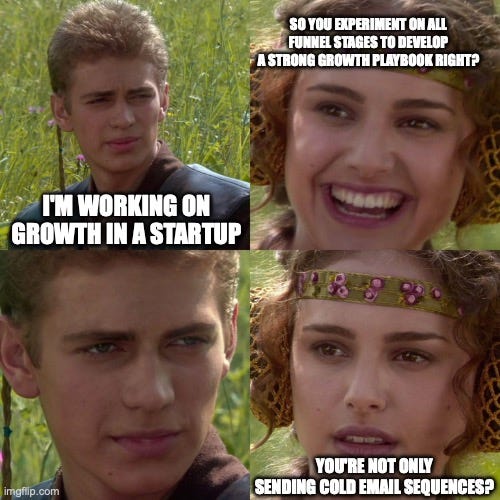The Ultimate Story of Growth - Part 1
The Genesis and Evolution of Growth Hacking
Hi Growth folks 👋 Welcome to this new edition of The Growth Mind!
I share every 2 weeks Growth strategies and case studies, inspired by the world’s leading scale-ups.
Today’s article -The Genesis and Evolution of Growth- is the first edition of a 2 posts series about the Story of Growth.
Part 2 will be released next week, so if you haven’t already, you can subscribe to receive it in your inbox.
Facebook & Chamath Palihapitiya - The beginning of the multidisciplinary growth approach
When we think about Growth Hacking (or Growth - whatever we want to call it), it’s always hard to precisely define its genesis.
As for every new concept and methodology, people start doing it without naming it.
That’s exactly what happened to Chamath Palihapitiya, one of the first Facebook employees.
When he joined in 2007, he started working on growing the activity of Facebook, focusing on increasing the number of Daily active users and the number of friends added by each user.
To grow these metrics, Chamath does not really have a specific focus area: he was experimenting with his team on all potential levers he could, whether it was Marketing, Product or Operations levers.
One day, Sheryl Sandberg (former Director of Operations) and Mark Zuckerberg (CEO & Co-founder) asked Chamath:
“What do you call this thing where you help change the product, do some SEO and SEM, and algorithmically do this or that?”
Chamath Palihapitiya answered: “I don’t know, I just call that, like, Growth, you know, we’re going to try to grow. I’ll be the head of growing stuff."
Source: https://brianbalfour.com/growth-machine/why-growth
And that’s how Growth started to become a named thing.
What is super interesting in this first approach to Growth which started at Facebook is that we already started to see what Growth teams look like in modern organizations:
A team composed of multidisciplinary profiles: Marketing, Product, Data, and Engineering.
Focusing on a specific set of KPIs: Daily active users.
Activating different levers, without boundaries: Product features, Marketing channels (SEO, SEM), automation and algorithms.
With a strong culture of experimentation (see the quote below).
Among the successes of Chamath Palihapitiya and his team at Facebook, one of the most famous is the finding of their “Aha moment”:
“After all the testing, all the iterating, all of this stuff, you know what? The biggest thing we realized: get any individual to 7 friends in 10 days.”
Source : Chamath Palihapitiya - how we put Facebook on the path to 1 billion users
This is a perfect example of how the rapid experimentation methodology, popularized later, led to some of the biggest growth successes of famous tech companies.
Sean Ellis & Dropbox - The emergence of “Growth hacking”
While the Growth methodology was incarnated at Facebook, it started to really become a popular thing when the approach was conceptualized and clearly named.
The myth says the term “Growth hacker” was invented by Sean Ellis back in 2010.
Sean Ellis is known especially for having kickstarted the growth at Dropbox, and more largely for having helped many other successful startups in Silicon Valley like Eventbrite or Lookout to achieve exponential growth through a unique methodology.
As he was working in Interim roles at those startups, one of his missions was to find a full-time replacement for his role once he had built the foundations for growth.
But Sean finds it difficult to precisely describe what his role was:
Was it marketing? Yes, partly. He worked a lot on building awareness and driving user sign-ups.
Was it product management? Also yes. A part of his work consisted of boosting engagement and retention, as well as monetizing the base of Dropbox users.
The role he had totally differed from traditional roles.
As Chamath did with his team at Facebook, Sean was helping startups grow by experimenting on different levers, whether it was launching new acquisition channels, revamping business models, or creating new product features.
To replace him, he wanted someone who is 100% focused on growth, with a data driven mindset and not afraid of shipping experiments. But this role had no name.
Guess what happened? He named this role a “Growth Hacker”.
Sean Ellis: "A person whose true north is growth. Everything they do is scrutinized by its potential impact on scalable growth."
Source: https://www.startup-marketing.com/where-are-all-the-growth-hackers/ - 2010
And that’s how the « Growth Hacking » concept appeared.
While the approach was not new, as we saw with the Facebook example before, Sean Ellis has been the man who clearly defined and popularized “Growth Hacking” and the role of a Growth hacker. He spent a lot of his time evangelizing the concept around him.
The emphasis of Sean Ellis definition of a Growth hacker is mainly on the mindset.
Before, marketing and product jobs were mainly relying on gut feeling and creativity. The focus was on building brand awareness through marketing campaigns on TV, radio or billboards (which of course still works) and designing beautiful packaging. Measuring performance was hard in a world where trackers and analytics tools did not exist, so the job and the skills needed were totally different.
The mid/end of the 2,000s marked a new era, with the rise of digital products and tracking:
The adoption of the internet became massive, opening the door to scalable digital products.
Popular tracking tools appeared (Google Analytics funded in 2005, Mixpanel in 2009), giving marketing and product people superpowers to assess the impact of their work.
So data was becoming more and more important, transforming the job of traditional marketers and product people relying on emotions and gut into a much more scientific approach, based on proven data.
In addition to this data-driven mindset, the definition of a Growth Hacker popularized by Sean Ellis also outlines the importance of rapid experimentation, which is at the heart of all big tech companies now.
Sean Ellis: “An effective growth hacker also needs to be disciplined to follow a growth hacking process of prioritizing ideas (their own and others in the company), testing the ideas, and being analytical enough to know which tested growth drivers to keep and which ones to cut.”
Source: https://www.startup-marketing.com/where-are-all-the-growth-hackers/ - 2010
That experimentation mindset, based on prioritization and testing, led to the creation of the Growth Hacking process, which is now a reference process used by Growth teams:
But how has Growth become so popular over the years? What created the crazy hype around it?
Well, a combination of different elements.
From Silicon Valley to the World - How Growth Spread Worldwide
While the concept of Growing a product through a data-driven approach, focusing on different funnel stages, was already there, “Growth Hacking” did not become instantly mainstream.
Actually, as the trend below shows, the worldwide spread started in 2014, to achieve a peak around 2018-2019 and now being a notion known (but not always understood) by everyone in the tech and startup world. But between 2010 to 2013, nobody knew what growth was.
So, how did Growth Hacking explode?
It takes time for a new concept to become mainstream. When Sean Ellis introduced Growth Hacking, it started to spread, but inside a very close community of tech folks in Silicon Valley. One person creating a concept is not enough to make it spread all over the world instantly. It needs to be adopted and incarnated by other people and companies.
What helped Growth Hacking spread largely are some famous examples who incarnated it:
Dropbox launched its unique referral program in 2008, accounting for 35% of its daily sign-ups, which unlocked exponential growth.
Airbnb: In their early days, Airbnb's founders sold custom-branded cereals, 'Obama O's' and 'Cap'n McCain's', during the 2008 U.S. presidential election at 40$ each box. They did it to make some cash for Airbnb, but the turning point was when they shared this story with investors. The legend says that, when they told Paul Graham (Y Combinator co-founder) this story, he said "If you can convince people to pay $40 for a $4 box of cereal, you can probably convince people to sleep in other people's homes.” He then decided to invest in Airbnb.
Hotmail: One of the earliest examples of growth hacking, Hotmail added a simple line at the end of every email sent out by its users: "PS: I love you. Get your free email at Hotmail." This tactic turned every email into a marketing touchpoint, leading to rapid user acquisition.
Those success stories helped to build hype around growth hacking. Not only because of the tactics used but mainly because they were used by some of the most famous successful startups of the Valley and have then been largely documented.
On the other hand, aside from those famous “Growth Hacks” more and more Silicon Valley startups started to build their Growth teams, creating cross-functional squads with marketers, product managers, engineers, and data analysts.
We talked about Facebook in the first part of the article, but some other famous examples exist Uber (documented here by Andrew Chen, partner at A16Z), Airbnb, Gusto, Lyft, and many more…
Over the years, Growth Hacking has been paired with the AARRR framework, introduced by Dave McClure in 2007 during a conference in Seattle.
Presented as the “Startup Metrics for Pirates”, the philosophy behind the AARRR framework fits well with the Hacking mindset and data-driven approach introduced by Sean Ellis and Silicon Valley startups.
The AARRR framework introduced a big difference with traditional marketing: instead of focusing on acquisition only (making people discover your product/service), the AARRR framework focuses on the entire customer journey.
The original slide from Dave’s conference where he introduced the AARRR framework:
It’s a framework that has been designed mainly for digital products, fully aligned with the data-driven and experimentation mindset of Growth Hacking.
Dave Mcclure was already outlining that a lot of Growth opportunities are now happening through the product (activation & retention stages).
Finally, in 2017, Sean Ellis and Morgan Brown released their book “Hacking Growth”, which is now a reference book in the industry.
It’s a book that is always mentioned in the top readings for marketers and product managers. Another piece that reinforced the worldwide spread of '“Growth Hacking” as a concept.
So if we do a summary of what we learned, Growth has originally been defined as:
A data-driven approach, focusing on rapid experimentation.
Mainly adopted by companies with high-growth potential digital products.
With a multidisciplinary approach, having teams composed of Marketers, Product Managers, Data analysts and Engineers.
Focusing on each stage of the user journey, from acquisition to monetization, passing through engagement and retention.
Sounds pretty cool, right?
But, with the worldwide spread, Growth Hacking started to become…a bit of nothing and everything at the same time.
While spreading over the world, Growth has been mainly misunderstood.
As for all the concepts becoming mainstream, Growth Hacking has been largely documented and misunderstood over the years. It even became a negative notion, referring to bad practices. “Hacking”, in popular opinion, generally refers to hackers launching malware and trojan horses to steal your data and erase everything on your computer. While it was definitely not the mindset behind the notion of Growth Hacking - more largely Growth - at the beginning, the way people communicated about it and interpreted it played a big role.
When I started to work in the startup & tech ecosystem in 2016, I did not even know what Growth was. I started to become interested in the topic in 2018/2019 when I was working at Koala, an early-stage insurance startup at the time (now running a healthy profitable business).
A part of my job was to create the Marketing and Sales engine. As we were targeting big accounts (airlines and OTAs), a large part of the strategy was personalized Outbound.
So I started to search for how we could automate personalized outbound at scale. That’s how I discovered “growth tactics” that were super popular at this time.
It was the rise of automated outbound and everyone (at least in Europe) was focusing on it.
A lot of people started to call automated outbound strategies “Growth”, talking about scrappy hacks to build a list of contacts and send them emails or LinkedIn messages. Some of them were also talking about social ads and SEA as part of Growth.
AARRR framework was a thing some people were talking about, but in reality, everyone was talking about acquisition tactics.
My comprehension of Growth back then was something like “Someone who is doing marketing, knows a thing or two about automation, and he’s creative enough to find hacks to boost some KPIs”.
This is indeed a part of Growth, but it’s missing a lot of the multidisciplinary team approach, focusing on all funnel levers, with a strong experimentation mindset.
Globally, some of the fundamentals of Growth were here, but the ecosystem lacked some professionalism to clearly present Growth as a holistic strategy to grow a product.
On the other hand, a large part of people kept only the '“Hacking” part. They were sharing some one-shot tactics that worked at a small scale, saying it would be a game changer for your business.
It makes many people think a “Growth Hacker” was a magician who was going to arrive at a startup, launch 10 hacks in 3 months, and transform the startup into a unicorn (I exaggerate of course, but you got the idea).
Now we see growth everywhere. It has become trendy to name every job offer with growth in it. But in reality, most of the Growth jobs consist of doing some ads and outbound, which is quite far from the original approach.
But the situation has been changing for a few years. Growth is becoming more and more documented by successful companies and tech influencers who have implemented holistic growth models; mainly coming from the US.
We hear less and less the “Hacking” word, to avoid thinking about Growth as something scrappy and short-term.
With the rise of concepts like Growth Loops, the emergence of structured growth teams orgs and the rise of Product-led strategies, we are now entering a modern, new era of Growth.
But that’s something we’ll talk about next week, in the Part 2 of the the Ultimate Story of Growth : The Modern & Future Growth Era












Thank you for your article ! Always interesting to remember where “Growth” came from
Great article - love those illustrations!
If you have a reading list/books to recommend, don't hesitate to share it ;)